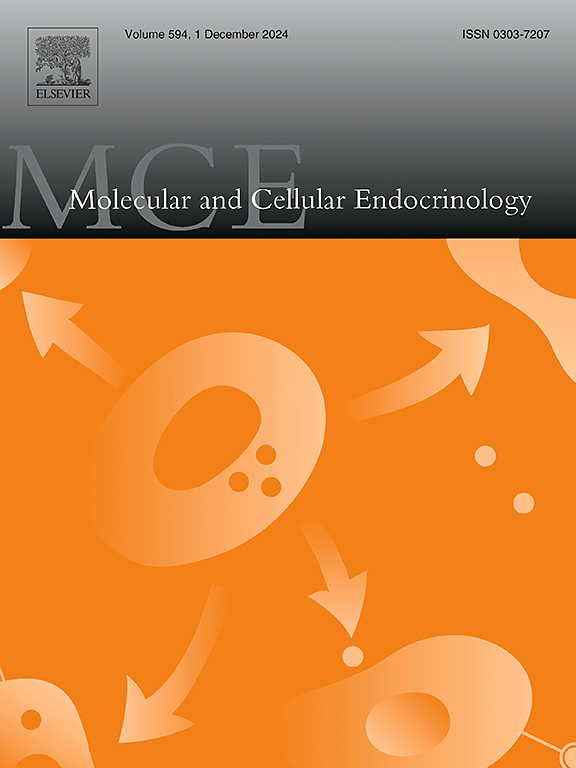二维和三维甲状腺素治疗的甲状腺功能减退细胞模型肝脂肪变性和纤维化的拉曼光谱表征。
IF 3.6
3区 医学
Q2 CELL BIOLOGY
引用次数: 0
摘要
原发性甲状腺功能减退与代谢功能障碍相关的脂肪变性肝病有关,并可能增加肝纤维化风险。虽然t4类似物药物是标准治疗方法之一,但其对肝脏的分子作用尚不完全清楚。为了阐明药物引起的肝脏代谢变化,我们建立了慢性人二维和三维甲状腺功能减退模型。采用拉曼光谱和补充生物技术观察T4对血脂和纤维化的影响。体外慢性甲状腺功能减退引起肝细胞脂滴(ld)积聚,而T4治疗不影响脂滴积聚。值得注意的是,TSH和T4以不同的方式影响TG脂肪酸饱和度:T4暴露的细胞以饱和脂肪酸为代价积累单不饱和脂肪酸。在肝纤维化的情况下,TSH治疗激活了肝星状细胞,证明胶原分泌增加,LD含量降低,无论T4联合治疗。数据证实,在3D肝脏模型中,TSH诱导促炎改变导致更高的炎性体水平。这些发现表明TSH水平升高的有害影响,值得注意的是,T4给药不能逆转肝脏脂质过载,但有能力改变其脂质组成。此外,在甲状腺功能减退细胞模型中,T4给药并不能逆转tsh诱导的肝纤维化。由于微拉曼光谱目前仅限于2D/3D体外系统,因此需要在完整组织和体内进一步验证。总之,我们的研究结果强调了进一步研究慢性甲状腺功能减退患者慢性肝损伤相关分子通路的重要性。本文章由计算机程序翻译,如有差异,请以英文原文为准。

Raman spectroscopic characterization of liver steatosis and fibrosis in a 2D and 3D in vitro thyroxine-treated hypothyroid cellular model
Primary hypothyroidism has been associated with metabolic dysfunction-associated steatotic liver disease and, potentially, increased liver fibrosis risk. Although T4-analog drug is one of the standard treatments, its molecular effects on the liver are not fully understood.
To elucidate drug-induced hepatic metabolic changes, chronic human 2D and 3D hypothyroid models were developed. The effects of T4 were assessed by Raman spectroscopy and complementary biological techniques to observe lipid and fibrotic changes. In vitro chronic hypothyroidism caused lipid droplet (LDs) accumulation in liver cells which was unaffected by T4 therapy. Notably, TSH and T4 influenced TG fatty acid saturation in different ways: T4-exposed cells accumulated monounsaturated fatty acids at the expense of saturated fatty acids. In the case of liver fibrosis, TSH treatment activated hepatic stellate cells as evidenced by increased collagen secretion and decreased LD content, regardless of T4 co-treatment. Data confirmed that TSH induced pro-inflammatory changes leading to higher inflammasome levels in a 3D liver model.
These findings indicate the detrimental effects of elevated TSH levels, and it is worth noting that T4 administration does not reverse the excess of hepatic lipid overload but has the ability to alter its lipid composition. Furthermore, T4 administration did not reverse TSH-induced hepatic fibrogenesis in the hypothyroid cell models. Because micro-Raman spectroscopy is currently restricted to 2D/3D in-vitro systems, further validation in intact tissue and in vivo is warranted. In conclusion, our results highlight the importance of further research into the molecular pathways associated with chronic liver injury in patients with chronic hypothyroidism.
求助全文
通过发布文献求助,成功后即可免费获取论文全文。
去求助
来源期刊

Molecular and Cellular Endocrinology
医学-内分泌学与代谢
CiteScore
9.00
自引率
2.40%
发文量
174
审稿时长
42 days
期刊介绍:
Molecular and Cellular Endocrinology was established in 1974 to meet the demand for integrated publication on all aspects related to the genetic and biochemical effects, synthesis and secretions of extracellular signals (hormones, neurotransmitters, etc.) and to the understanding of cellular regulatory mechanisms involved in hormonal control.
 求助内容:
求助内容: 应助结果提醒方式:
应助结果提醒方式:


